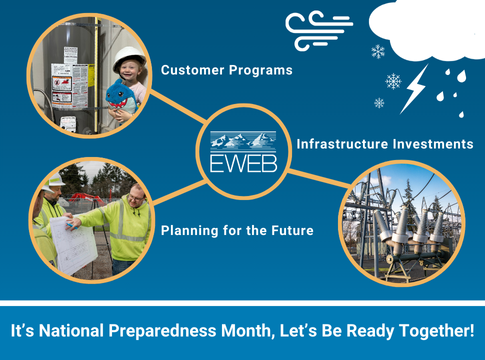Related News
Related News
-
Greenpower subscribers vote to award Greenpower Grant to SquareOne Villages
The Greenpower Grant, funded solely by voluntary customer subscriptions, supports local sustainability projects.
Find Out More -
EWEB reaffirms commitment to resilience with Wildfire Mitigation Plan approval
The utility is testing new equipment, leveraging technology, and incorporating third-party expertise to bolster electric system resiliency to a range of threats, including wildfire.
Find Out More -
Water professionals showcase skills in Cascade to Coast Competition
Representatives from local utilities competed to see who has the best-testing water, who can assemble a water meter the fastest and who find the most creative way to solve a routine problem that water utility professionals often face.
Find Out More -
Small number of McKenzie Valley EWEB customers face higher February bills due to estimated reads
EWEB under-estimated energy usage for about one-fifth of upriver customers in December or January, resulting in higher true-up bills in February.
Find Out More -
EWEB offers Greenpower Grant to support local sustainability project
The Greenpower Grant, funded by voluntary customer subscriptions to Greenpower, not customer grants, supports projects that advance renewable energy, clean energy education or efforts to reduce or offset local carbon emissions.
Find Out More -
Rising Together: Female operation staffers begin industry mentorship program
One week into Women's History Month and just before International Women's Day on March 8, three women in EWEB leadership roles embarked on a 10-month-long journey of mentorship, fellowship, and professional development.
Find Out More -
EWEB and BRING cook up new ways to help Eugene businesses save energy
Businesses can cut energy costs with EWEB’s free Energy Assessments and efficiency programs. Plus, for a limited time, BRING is offering $1,000 rebates for qualifying upgrades—apply by Feb. 28!
Find Out More -
EWEB Board Adopts 2025 Goals
Goals focus on supporting low-income community members and renters, while improving operational efficiency.
Find Out More -
PNW Lineman Rodeo raises $85,000 for Oregon Burn Center
EWEB line techs are proud partners and participants in the rodeo fundraiser every year.
Find Out More -
EWEB customers and employees share the love through Energy Share donations
EWEB budgets funding to help customers struggling to pay their utility bill, but the need is always greater than what we can provide alone. Energy Share, our customer donation funded program helps fill the gap.
Find Out More -
Energy demand reaches highest level in nearly a decade as utility prepares for ice
Frigid temperatures in the low 20s caused surging electricity demand in early February.
Find Out More -
EWEB leverages Oregon Clean Fuels Program to support electric mobility
Five grants support programs benefiting homeless youth and bike sharing, among others.
Find Out More -
Frigid weather drives highest energy demand of the winter so far
Peak electricity demand this season surpasses demand levels during last year’s ice storm.
Find Out More -
Recovery still ongoing on the anniversary of the 2024 Ice Storm
Cost of rebuilding EWEB's electrical system will surpass $11 million
Find Out More -
Favorite Photos of 2024
Communications Specialist and "Resident EWEB Photographer" Adam Spencer shares his favorite photos - and the stories behind them - from a busy year of getting things done, being part of the community, and inspiring the next generation of stewards.
Find Out More - Show More
EWEB invests in preparedness for severe weather and natural disasters
August 29, 2024 • Robyn Smith, EWEB Communications

Severe weather events like January’s back-to-back ice storms and natural disasters such as wildfires and earthquakes remind us of the importance of being prepared, a responsibility we all must share. Just as you take steps to safeguard your home and family, EWEB invests in equipment and processes to ensure our community’s electric and water systems remain reliable in the face of adversity.
Often, we say emergencies are “unexpected,” but today’s environment requires us to prepare for the inevitable. Preparedness is about planning for the worst situation to “weather the storm.” The electric grid and drinking water systems we rely on can be impacted by age, natural disasters, and climate change.
That’s why EWEB is investing to maintain reliability when disaster strikes because without preparation, there is a high possibility of system failures.
The investment
EWEB, a cost-based community-owned utility, plans to invest nearly $120 million in electric and drinking water infrastructure in 2025 and about $1 billion over the next decade to address aging infrastructure and increased risks of natural disasters. Like utilities across the region, EWEB expects to increase customer rates to fund these necessary investments. Additionally, EWEB continues to apply for and receive Federal Grant Funding to advance wildfire mitigation technologies which will help offset the costs of these investments.
In the summer of 2024, customer funds are being put to use, funding several weather-related reliability projects. These include pilot programs for enhanced electric equipment, installation of weather stations to increase situational awareness, and coordination with local agencies to develop a county-wide natural hazard mitigation plan that addresses both electric and water infrastructure.
Key community preparedness investments
Fault indicators
We are replacing over 150 fault indicators on power lines in the High Fire Risk Zone (HFRZ). These new devices attach to the power line between poles, about the size of a hockey puck with a small dome atop. When an outage occurs on a section of line, these indicators light up, helping crews locate the specific location of the issue, even at night. This technology significantly reduces the time spent patrolling powerlines to find the cause of an outage, speeding repair and restoration time.

The HFRZs, with their dense tree canopies, are more prone to power line trips, especially during the summer when we apply wildfire protective settings. These settings are highly sensitive and will trip instantaneously if a problem is sensed, like a tree branch tapping the line. We will not re-energize the line until we visually inspect it and confirm with public safety partners that there is no fire in the area and that the line is safe to re-energize. This inspection process usually results in longer than normal outages.
“These new fault indicators coordinate with our wildfire safety settings and are equipped with flashing LED lights. With this equipment, we expect faster power restoration while maintaining vigilance against wildfire risks,” said EWEB Resiliency Program Manager Jeannine Parisi.
South Eugene Weather Station
EWEB recently installed a new weather station in South Eugene near Blanton Heights to enhance local forecasting accuracy and improve situational awareness during wildfire weather conditions. This is the second EWEB-owned station; the first was installed atop the Hayden Bridge Water Filtration Plant in east Springfield. These weather stations provide real-time, localized wind and humidity data and enable us to set automated notifications to alert us to critical weather conditions, such as high winds during wildfire season. Local weather data is essential to making safety-focused operational decisions consistent with our wildfire mitigation plan. Data from both stations are fed into the broader weather station network used by the National Weather Service.

County-wide Natural Hazard Mitigation Plan (NHMP)
FEMA requires states, tribal, and local governments to develop and adopt Natural Hazard Mitigation Plans as a condition for receiving certain types of non-emergency disaster assistance, including grant funding for mitigation projects. EWEB has participated in the Eugene-Springfield NHMP since 2014.
Consistent with EWEB’s capital improvement plans prioritizing resiliency, EWEB’s annex to the 2020 NHMP included over $25M in electric system upgrades and almost $50M in water system projects.
Since adopting the 2020 NHMP, EWEB has secured over $2.5M in FEMA Hazard Mitigation Advanced Assistance funds, about $1.2 for watershed recovery and restoration work, and the remainder for water transmission line feasibility studies at Day Island and Knickerbocker Bridge.
The current Eugene-Springfield NHMP expires in early 2025. EWEB, along with the other public agency partners, is now in the process of updating and transitioning to join the Lane County NHMP. In addition to considerable administrative efficiencies, having one County-wide plan supports consolidated risk planning and improved mitigation project coordination among regional partners. This change makes sense for EWEB as we have assets and customers outside urban jurisdictions.
During the August EWEB Board meeting, commissioners reviewed the draft EWEB annex to the Lane County NHMP, which includes updates on prior mitigation action commitments, re-evaluates natural hazards risks, and identifies mitigation actions for each hazard. In the updated annex, earthquake and winter storms ranked as the highest risk to the public and utility infrastructure. Read more here.
Over the past few weeks, EWEB has asked customers to weigh in on the annex through an NHMP survey. In the coming weeks, EWEB will finalize and present its findings for integration into the County-wide plan.
Satellite-based forestry analytics for vegetation management
Vegetation management is an essential tool in EWEB's power outage mitigation toolbox. During severe weather events, hazardous falling trees and snapped branches coming down on power lines create prolonged outages and unsafe working conditions.
EWEB maintains over 1,300 miles of overhead transmission and distribution lines. To aid crews in identifying where there’s been more vigorous tree growth near electric facilities, we’re trying out a new satellite-based forestry analytics software. This technology provides a bird’s eye view of the tree canopy around powerlines to pinpoint areas that could benefit from additional vegetation work. It also creates a heat map showing places with clusters of dead or dying trees so that we can top or remove trees that pose a hazard to our equipment.
Parisi said, “The goal is to prioritize tree-trimming work to areas that improve reliability most efficiently.” The first year’s analysis, focused on the areas with denser tree coverage in South Eugene and east of Springfield, confirmed that EWEB’s current vegetation management practices are very effective at maintaining regulatory clearance from powerlines.
This year’s satellite imagery was captured in the early summer and included a wider cross-section of EWEB’s service territory. “I’m really interested to see the difference in this year’s results, particularly after the January ice storm and all the tree damage that occurred,” Parisi added.
This forward-thinking vegetation management tool is just one example of how EWEB proactively invests today to prepare for a resilient tomorrow.

Related Programs
Here are some of the ways we work proactively to keep the lights on and the tap water flowing.
We offer financing options for customers to purchase a backup power system.
You can significantly reduce damage to your home by fixing a number of known and common weaknesses. This FEMA booklet is a good start to begin strengthening your home against earthquake damage.





